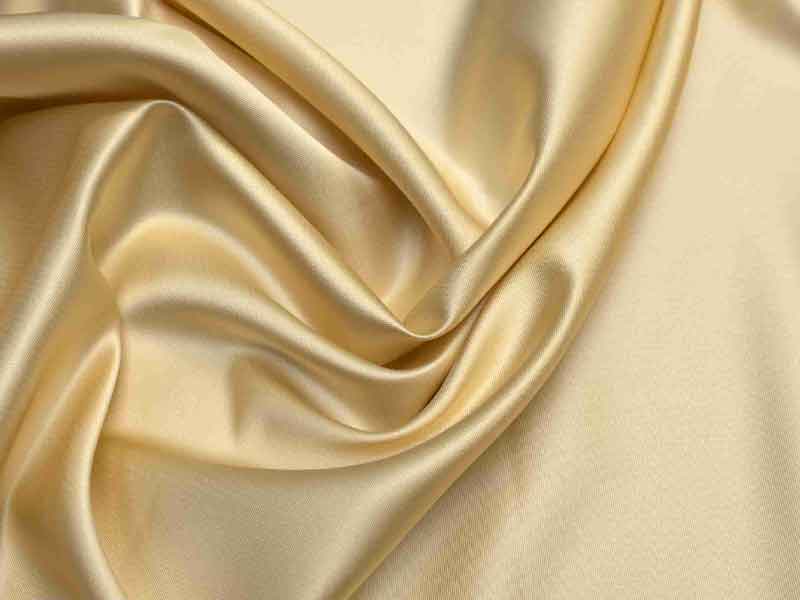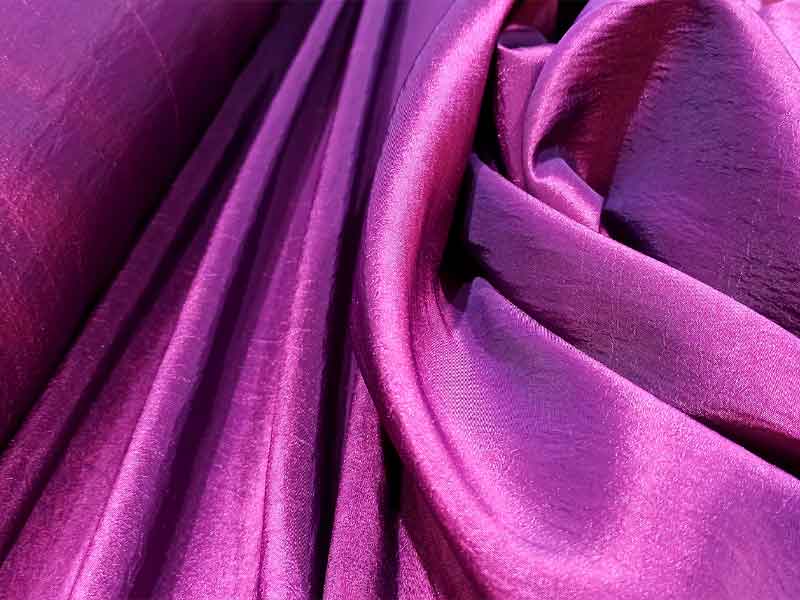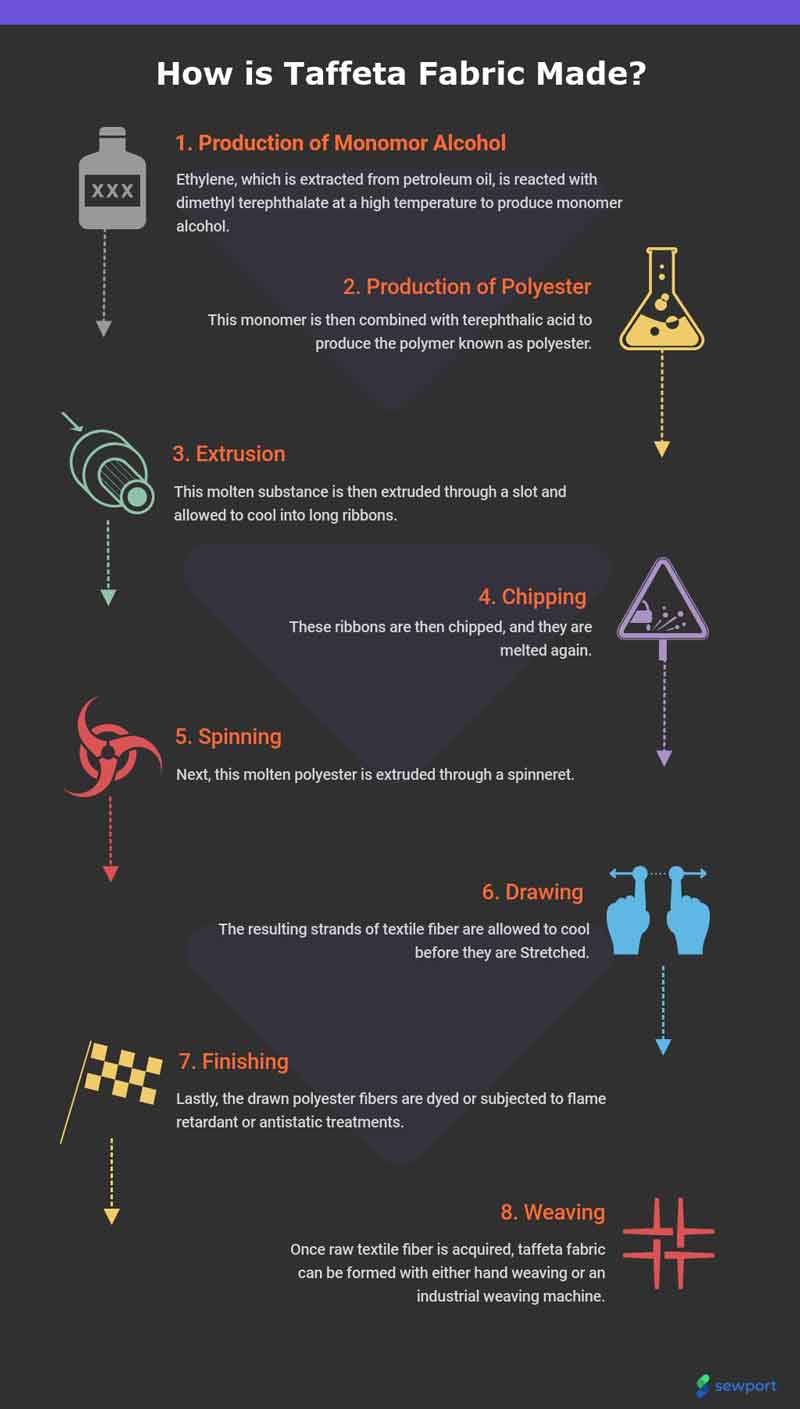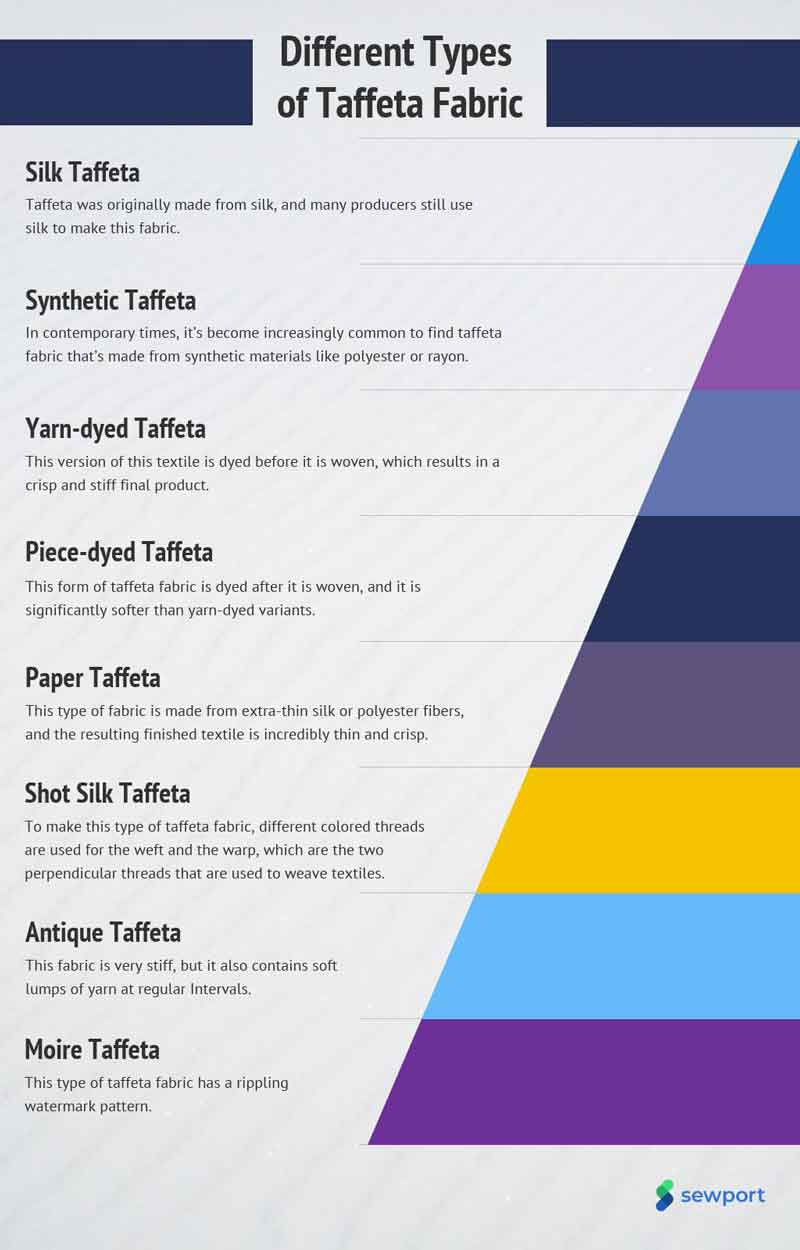Mục lục
What is Taffeta fabric?
Taffeta is a crisp, light fabric commonly used to make a variety of high-end women’s apparel. This plain weave is very smooth to the touch and can be made from a variety of materials.
The word “taffeta” is derived from tafta, which means “twisted weave” in Persian. While it is true that taffeta is made by twisting the yarn as it is woven, many other fabrics are also made using this method, which means that the taffeta’s starch and shape retention qualities exhibit many unique properties. unique.

Traditionally, taffeta was made from silk, but with the advent of synthetic fibers in the 20th century, textile manufacturers began to produce this fabric from materials such as rayon and polyester. While it is still possible to find silk taffeta, it is much more common to find versions of this fabric made from polyester.
| Fabric name | Taffeta |
| Fabric is also known as | Paper taffeta, shot silk |
| Ingredient of cotton | Silk, rayon, or polyester |
| Breathable fabric | Very breathable |
| Ability to absorb moisture | Low |
| The ability to retain heat | Low |
| Stretchability (for) | Low |
| prone to clumping/bubbling | Không có |
| The country where the fabric was first produced | Persian |
| Today’s largest exporting/producing country | India |
| Recommended washing temperature | Hand wash cold or dry clean |
| Commonly used in | Wedding gowns, evening gowns, blouses, party wear, curtains, insulation, sleeping bags |
Although the term “taffeta” has been used to describe lightweight silk garments for nearly a thousand years, it remains unclear whether taffeta fabrics of the distant past resemble today’s fabrics.
Taffeta was also used in a number of aeronautical experiments in the 18th century. In more recent times, taffeta fabric has even been used in artificial vascular studies due to its paper-thin texture and durability. It.

One of the most notable attributes of taffeta is its ability to hold its shape. Many other delicate fabrics tend to lose their shape as they are worn, but taffeta’s stiff texture allows the fabric to be shaped into a number of different forms without distortion or distortion throughout.

When wearing taffeta, it produces a relatively noisy rustle due to its brittleness. Depending on the taffeta fabric, the fabric can create an iridescent effect when the wearer moves or its paper-thin and breathable texture. The unique qualities of this fabric have earned it an important public place as a luxury fabric, such as silk, which has been widely replaced by polyester and rayon.
How is Taffeta fabric made?
Taffeta is a fabric made from various formulations depending on the type of raw materials used in production. Silk production, for example, includes growing and harvesting silkworm cocoons. The process is highly environmentally sustainable, but the silkworms die as a result.

After the silk trumpets are boiled, they are turned or “rolled up” and filtered out the silk threads then pumped into non-toxic mild vinegar. Finally, this wire will be spun into yarn. However, some taffeta fabrics are dyed after a fabric has been woven.
Although some taffeta fabrics are made from semi-synthetic materials such as cuprammonium rayon, it is commonly found manufactured from polyester. Since polyester is a one-way chemical fabric, its manufacturing process differs greatly from the process used to create silk.

Polyester is a product obtained from a compound called ethylene, which is a component of oil. This ethylene is reacted with dimethyl terephthalate at high temperature, producing alcohol. This alcohol is then combined with terephthalic acid to create a polymer known as polyester.
This fuel is then pressed through a slot and left to cool into tongue strings. These tongue cords are then protected and re-ignited. This polyester fuel is then pressed through a spinneret cutter and the resulting fabric filters are cooled before being stretched in a process known as “dragging”. Finally, the spun polyester fabric filters are either colored or subjected to flame retardancy or electrical mixing.

Once a synthetic filter is available, taffeta can be fabricated either by hand or by industrial looms. A special twisting process is used to provide the smooth and gentle characteristics of this fabric. Depending on the type of taffeta being produced, it can be dyed before or after weaving.
How is Taffeta fabric used?
Taffeta is considered a luxurious fabric and is relatively easily damaged. Therefore, it is not commonly used in everyday clothing; on the contrary, it is common to see this fabric used in expensive outfits such as wedding dresses and evening gowns.

Due to its iconic rustle and light weight, this fabric is often used in party wear. For example, it is often used to make party costumes, and it can also be used to make costumes for stage plays. Due to its soft nature, finely dyed taffeta is sometimes used to make linings for jackets and coats.

In addition to apparel, taffeta is also used to produce a number of consumer goods. For example, umbrellas are often made of this fabric, and taffeta is also used to provide some form of insulation. In addition, the substance was sometimes used to make handbags and the material in sleeping bags, and during World War II, the fabric was often used to make parachutes.
Where is Taffeta fabric produced?
Silk taffeta was originally produced in Ancient Persia, but it is unclear how similar the fabric is to modern taffeta. Over the years, the production of this fabric has spread to China and India, which remain the world’s largest silk producers.

Although this fabric is still produced in the Middle East to some extent, mills in India have been the leading producer of taffeta for centuries. This fabric is also produced in Pakistan and China, the leading producer of most textiles, also has many factories producing this fabric whether it is made from silk or synthetic materials.
Mills in India only started using mechanical looms to produce textiles in the 1990s, and while high-quality taffeta was made in China between 1970 and 1990, the country no longer produces them. produce this fabric in its highest quality form as well. Modern taffeta was originally developed in France and Italy in the late 19th century, and the finest fabrics are still produced in Western countries. Russia is also a relatively large exporter of this textile item.
How much does Taffeta fabric cost?
The cost of this fabric varies depending on the material from which it is made and the taffeta variant in question. For example, silk is much more expensive than polyester, but most experts agree that silk taffeta is better than synthetic forms of the substance.
Although taffeta is made with many different types of synthetic textiles, most of these textiles are priced roughly the same. However, polyester fabric can be cheaper than cuprammonium rayon fabric due to the disparity between global production volumes.
What types of Taffeta fabrics are there?
There are quite a few different types of these fabrics, and it’s important to be familiar with the differences between each:

– Silk Taffeta: Taffeta was originally made from silk, and many manufacturers still use silk to make this fabric.
– Synthetic taffeta: In modern times, taffeta fabric made from synthetic materials such as polyester or rayon is becoming more and more popular.
– Yarn Dyed Taffeta: This fabric is dyed before weaving, creating a crisp and stiff end product.
– Finely dyed taffeta: This form of taffeta is dyed after weaving and is considerably softer than yarn-dyed variations.
– Paper Taffeta: This fabric is made from extremely thin silk or polyester fibers, and the resulting fabric is extremely thin and crisp.
– Silk taffeta: To make this taffeta fabric, threads of different colors are used for the weft and warp, which are two perpendicular threads used to weave the fabric. The resulting fabric appears iridescent and displays different colors when viewed from different angles. Although this fabric is sometimes made from polyester, silk is still the preferred material for silk taffeta. This fabric is also known as chiné or Pompadour taffeta.
– Old Taffeta: This fabric is very stiff, but it also contains evenly spaced lumps of soft yarn.
– Glitter Taffeta: This taffeta has a wavy watermark pattern.
How does Taffeta affect the environment?
The way taffeta affects the environment varies depending on the type of fiber from which it is made. Among the different substances used to make this fabric, silk is by far the most environmentally friendly.
The only way that silk production has a negative impact on the environment is through the destruction of live silkworms. While this can be a problem for animal rights organisations, most textile enthusiasts and environmentalists accept the minimal environmental impact of silk compared to damage caused by synthetic or semi-synthetic textile fibers.
Silkworms live their entire lives on the surface of mulberry trees and do not need pesticides or fertilizers to grow these plants. The silk production process does not require the use of any caustic chemicals and in most cases eco-friendly dyes are used to color this fabric.
In addition, silk is completely biodegradable; Once silk clothing is discarded, it will be recovered by the environment within a few years or decades. This attribute assures consumers that their purchase of silk products will not contribute significantly to pollution.
However, both polyester and rayon are significantly detrimental to the environment in a number of ways. Polyester is derived from petroleum, which is an unsustainable resource. There is only a limited amount of petroleum left in the world, and because this substance is also used to make many plastics, fuels, and oils, it is often in high demand and in short supply.
Many hazardous chemicals are used in the production of polyester, and some of these chemicals can be released into the environment if they are not properly contained by the manufacturing plants. In addition, polyester is not biodegradable; It is estimated that polyester clothing will remain a pollutant in the ecosystem for centuries or even millennia after they are eliminated.
Cuprammonium rayon, which is the most commonly used rayon to make taffeta, is somewhat better for the environment than other forms of rayon as it is produced using a closed extraction process. However, the solvents used to produce cuprammonium rayon are harmful to the environment when they are not handled properly. While rayon is technically biodegradable because it’s made of plant cellulose, the product is semi-synthetic, which means it’s not absorbed as quickly into the environment as other fibers. completely organic.
Taffeta fabric certificate is available
This fabric may qualify for a variety of certifications depending on the material from which the fabric is made. For example, when silk fabric is produced in the United States, it may qualify for U.S. Department of Agriculture (USDA) organic certification if produced to sustainable and non-toxic standards. The European Union organic product certification service can provide similar certification for silk products grown in Europe.
If the taffeta is made from synthetic substances, such as polyester, it may qualify for Global Recycling Standard (GRS) certification if made with 100% recycled materials. On the other hand, the quality of a polyester or rayon taffeta fabric product can be determined based on whether the product is labeled as ISO 9001 compliant. If an American-made textile product has also been certified by the American National Standards Institute (ANSI), that product is guaranteed to be of high quality.

 日本語
日本語 Tiếng Việt
Tiếng Việt






Bài viết liên quan: